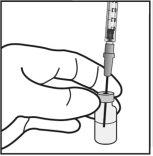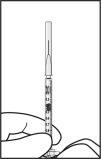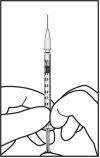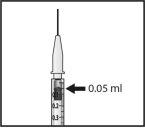
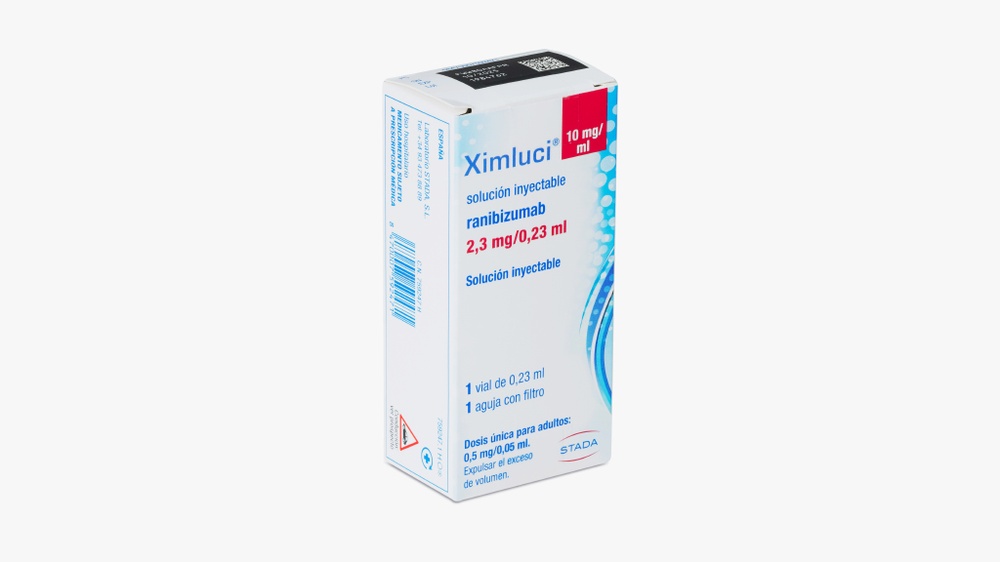
КСІМЛУЦІ 10 мг/мл РОЗЧИН ДЛЯ ІН'ЄКЦІЙ

Запитайте лікаря про рецепт на КСІМЛУЦІ 10 мг/мл РОЗЧИН ДЛЯ ІН'ЄКЦІЙ

Інструкція із застосування КСІМЛУЦІ 10 мг/мл РОЗЧИН ДЛЯ ІН'ЄКЦІЙ
Введення
Опис: інформація для пацієнта
Хімлуці 10 мг/мл ін'єкційне розчин
ранібізумаб
ДОРОСЛІ
Цей лікарський засіб підлягає додатковому моніторингу, що прискорить виявлення нової інформації про його безпеку. Ви можете допомогти, повідомивши про будь-які побічні ефекти, які ви можете мати. Остання частина розділу 4 містить інформацію про те, як повідомляти про ці побічні ефекти.
Прочитайте уважно весь опис перед тим, як вам буде введено цей лікарський засіб, оскільки він містить важливу інформацію для вас.
- Збережіть цей опис, оскільки вам може знадобитися знову його прочитати.
- Якщо у вас є якісь питання, проконсультуйтеся з вашим лікарем.
- Якщо ви відчуваєте побічні ефекти, проконсультуйтеся з вашим лікарем, навіть якщо це побічні ефекти, які не наведені в цьому описі. Див. розділ 4.
Зміст опису
- Що таке Хімлуці і для чого він використовується
- Що вам потрібно знати перед тим, як вам буде введено Хімлуці
- Як вводиться Хімлуці
- Можливі побічні ефекти
- Збереження Хімлуці
Зміст упаковки та додаткова інформація
1. Що таке Хімлуці і для чого він використовується
Що таке Хімлуці
Хімлуці - це розчин, який вводиться в око. Хімлуці належить до групи лікарських засобів, званих антинеоваскулярними агентами. Він містить активну речовину під назвою ранібізумаб.
Для чого використовується Хімлуці
Хімлуці використовується у дорослих для лікування різних захворювань очей, які викликають порушення зору.
Ці захворювання є результатом пошкодження сітківки (чутливої до світла частини в задній частині ока) внаслідок:
- Росту аномальних судин, які втрачають рідину. Це спостерігається при захворюваннях, таких як вікова макулярна дегенерація (ВМД) та проліферативна діабетична ретинопатія (ПДР, захворювання, викликані цукровим діабетом). Також це може бути пов'язано з хоріоїдальною неоваскуляризацією (ХНВ) через патологічну міопію (ПМ), ангіоїдні стрії, центральну серозну хоріоретинопатію або ХНВ, пов'язану з запаленням.
- Макулярного набухання (набухання центру сітківки). Причина цього набухання може бути цукровим діабетом (захворювання, відоме як діабетичне макулярне набухання (ДМН)) або блокуванням ретинальних вен сітківки (захворювання, відоме як оклюзія ретинальної вени (ОРВ)).
Як діє Хімлуці
Хімлуці визнає і зв'язується з певною білковою речовиною під назвою фактор росту ендотелію судин А (VEGF-A) людини, присутньою в очах. У надмірній кількості VEGF-A викликає рост аномальних судин і набухання в оці, що може викликати порушення зору при захворюваннях, таких як ВМД, ДМН, ПДР, ОРВ, ПМ та ХНВ. За допомогою зв'язування з VEGF-A Хімлуці може запобігти його дії і попередити такий аномальний рост і набухання.
При цих захворюваннях Хімлуці може допомогти стабілізувати і, в багатьох випадках, покращити зір.
2. Що вам потрібно знати перед тим, як вам буде введено Хімлуці
Хімлуці не повинні бути введені вам
- Якщо ви алергічні на ранібізумаб або на будь-який інший компонент цього лікарського засобу (перелічені в розділі 6).
- Якщо у вас є інфекція в оці або навколо нього.
- Якщо у вас є біль або червоність (важкий внутрішньоочний запалення) в оці.
Попередження та застереження
Проконсультуйтеся з вашим лікарем перед тим, як вам буде введено Хімлуці
- Хімлуці вводиться шляхом ін'єкції в око. Іноді після лікування Хімлуці може виникнути інфекція в внутрішній частині ока, біль або червоність (внутрішньоочне запалення), відшарування або розрив однієї з шарів, розташованих в задній частині ока (відшарування або розрив сітківки і відшарування або розрив пігментного епітелію сітківки), або затуманення кришталика (катаракта). важливо виявити і лікувати таку інфекцію або відшарування сітківки якнайшвидше. Повідомте своєму лікареві негайно, якщо ви відчуваєте симптоми, такі як біль в оці або збільшення дискомфорту в оці, якщо погіршується червоність в оці, зір розмитується або зір знижується, збільшення кількості малих плям у полі зору або збільшення чутливості до світла.
- У деяких пацієнтів після ін'єкції тиск в оці може збільшитися протягом короткого періоду часу. Можливо, ви не будете помічати цього, тому ваш лікар може проводити моніторинг окулярного тиску після кожної ін'єкції.
- Повідомте своєму лікареві, якщо у вас були захворювання очей або ви отримували лікування очей раніше, або якщо у вас був інсульт або були тимчасові симптоми інсульту (слабкість або параліч члена або обличчя, труднощі з мовою або розумінням). Ця інформація буде врахована для оцінки того, чи є Хімлуці відповідним лікуванням для вас.
Для отримання більш детальної інформації про побічні ефекти, які можуть виникнути під час лікування Хімлуці, див. розділ 4 («Можливі побічні ефекти»).
Діти та підлітки (молодше 18 років)
Не рекомендується використовувати Хімлуці у дітей та підлітків, оскільки це не було встановлено в цих вікових групах.
Інші лікарські засоби та Хімлуці
Повідомте своєму лікареві, якщо ви використовуєте, нещодавно використовували або можете використовувати будь-який інший лікарський засіб.
Вагітність та лактація
- Жінки, які можуть завагітніти, повинні використовувати ефективний метод контрацепції під час лікування та протягом至少 трьох місяців після останньої ін'єкції Хімлуці.
- Немає досвіду використання Хімлуці у вагітних жінок. Хімлуці не повинні бути використані під час вагітності, якщо потенційний виграш не переважує потенційний ризик для плода. Якщо ви вагітні, вважаєте, що можете бути вагітною або плануєте завагітніти, проконсультуйтеся з вашим лікарем перед лікуванням Хімлуці.
- Не рекомендується використовувати Хімлуці під час лактації, оскільки невідомо, чи Хімлуці потрапляє до грудного молока. Проконсультуйтеся з вашим лікарем або фармацевтом перед лікуванням Хімлуці.
Водіння транспортних засобів та використання машин
Після лікування Хімлуці ви можете тимчасово відчувати розмитість зору. Якщо це відбувається, не водьте транспортні засоби та не використовуйте машини, доки цей симптом не зникне.
3. Як вводиться Хімлуці
Хімлуці вводиться офтальмологом у вигляді однієї ін'єкції в око під місцевою анестезією. Звичайна доза однієї ін'єкції становить 0,05 мл (що містить 0,5 мг активної речовини). Інтервал між двома дозами, введеними в одне й те саме око, повинен бути не менше чотирьох тижнів. Всі ін'єкції будуть введені офтальмологом.
Для профілактики інфекції перед ін'єкцією ваш лікар буде ретельно мити око. Ваш лікар також введе місцевий анестетик, щоб зменшити або запобігти будь-який біль, який ви можете відчувати під час ін'єкції.
Лікування починається з ін'єкції Хімлуці один раз на місяць. Ваш лікар буде контролювати захворювання вашого ока і залежно від того, як ви реагуєте на лікування, вирішить, чи потрібно вам продовжувати лікування та коли вам потрібно лікувати.
У кінці опису в розділі «Як підготувати та введити Луцентіс у дорослих» наведені детальні інструкції з використання».
Пацієнти похилого віку (65 років та старше)
Хімлуці можуть бути використані у осіб віком 65 років та старше, і не потрібно коригування дози.
Перед припиненням лікування Хімлуці
Якщо ви розглядаєте можливість припинення лікування Хімлуці, відвідайте наступний прийом та обговоріть це з вашим лікарем перед тим. Ваш лікар порадить вам і вирішить, протягом якого часу вам потрібно лікувати Хімлуці.
Якщо у вас є якісь інші питання щодо використання цього лікарського засобу, проконсультуйтеся з вашим лікарем.
4. Можливі побічні ефекти
Як і всі лікарські засоби, цей лікарський засіб може викликати побічні ефекти, хоча не всі люди їх відчувають.
Побічні ефекти, пов'язані з введенням Хімлуці, можуть бути викликані самим лікарським засобом або процедурою ін'єкції, і більшість з них впливають на око.
Важкі побічні ефекти:
Часті(можуть виникнути у до 1 з 10 пацієнтів)
- відшарування або розрив одного зі шарів у внутрішній частині ока (відшарування або розрив сітківки), що призводить до появи світлових блисків з плаваючими частинками, які прогресують до тимчасової втрати зору або затуманення кришталика (катаракти)
Нечасті(можуть виникнути у до 1 з 100 пацієнтів)
- сліпота,
- інфекція очного яблука (ендофтальміт) з запаленням внутрішньої частини ока
Симптоми, які ви можете відчувати, включають:
- біль або збільшення дискомфорту в оці
- погіршення червоності в оці
- зір розмитується або зір знижується
- збільшення кількості малих плям у полі зору
- збільшення чутливості до світла
Повідомте своєму лікареві негайно, якщо ви відчуваєте будь-який з цих побічних ефектів.
Інші побічні ефекти:
Дуже часті(можуть виникнути у більш ніж 1 з 10 пацієнтів)
Побічні ефекти ока включають
- запалення ока
- кровотеча в задній частині ока (геморагія в сітківці)
- зміни зору
- біль в оці
- малі частинки або плями у полі зору (плаваючі частинки)
- кров в оці
- іритація ока
- чуття чогось у оці
- збільшення виробництва сліз
- запалення або інфекція на краю повік
- сухе око
- червоність або свербіж в оці
- збільшення тиску в оці
Побічні ефекти, не пов'язані з оком, включають
- біль у горлі, кон'юнктивіт, гайморит
- головний біль
- біль у суглобах
Часті(можуть виникнути у до 1 з 10 пацієнтів)
Побічні ефекти ока включають
- зниження ясності зору
- набухання однієї з частин ока (увеї, рогівки)
- запалення рогівки (передньої частини ока)
- малі плями на поверхні ока
- зір розмитується
- кровотеча в місці ін'єкції
- кровотеча в оці
- секреція ока з свербінням, червоністю та набуханням (кон'юнктивіт)
- чутливість до світла
- дискомфорт в оці
- набухання повіка
- біль у повіці
Побічні ефекти, не пов'язані з оком, включають
- інфекція сечових шляхів
- низький рівень червоних кров'яних тілець (з симптомами, такими як втома, труднощі з диханням, головокружіння, блідість)
- тривога
- кашель
- нудота, алергічні реакції, такі як висип, кропив'янка, свербіж та червоність шкіри
Нечасті(можуть виникнути у до 1 з 100 пацієнтів)
Побічні ефекти ока включають
- запалення та кровотеча в передній частині ока
- нагромадження гною в оці
- зміни в центральній частині поверхні ока
- біль або свербіж в місці ін'єкції
- анормальне чуття в оці
- іритація повіка
Повідомлення про побічні ефекти
Якщо ви відчуваєте будь-який побічний ефект, повідомте своєму лікареві, навіть якщо це побічний ефект, який не наведений в цьому описі. Ви також можете повідомити про них безпосередньо через національну систему повідомлення, включену в додаток V. Повідомлення про побічні ефекти допоможе надати більше інформації про безпеку цього лікарського засобу.
5. Збереження Хімлуці
- Тримайте цей лікарський засіб поза зоною досяжності дітей.
- Не використовуйте цей лікарський засіб після закінчення терміну придатності, вказаного на коробці та на етикетці флакона після CAD. Термін придатності - останній день місяця, який вказано.
- Тримайте в холодильнику (між 2°C та 8°C). Не заморожуйте.
- До використання флакон без відкритої кришки можна тримати при кімнатній температурі (25°C) протягом максимум 48 годин.
- Тримайте флакон у зовнішній упаковці, щоб захистити його від світла.
- Не використовуйте жодну упаковку, яка пошкоджена.
6. Зміст упаковки та додаткова інформація
Склад Ximluci
- Активний інгредієнт - ранібізумаб. Кожен мл містить 10 мг ранібізумабу. Кожна флакон містить 2,3 мг ранібізумабу в 0,23 мл розчину. Це забезпечує використовну кількість для забезпечення однієї дози 0,05 мл, яка містить 0,5 мг ранібізумабу.
- Інші компоненти - трегалоза дигідрат; гідрохлорид гістидину моногідрат; гістидин; полісорбат 20; вода для ін'єкцій.
Вигляд продукту та вміст упаковки
Ximluci - це прозорий або легкий опалесцентний ін'єкційний розчин, безбарвний або злегка коричневий, вміщений у флаконі (0,23 мл).
Існують два різних типу упаковок:
Упаковка тільки з флаконом
Упаковка, що містить скляний флакон з ранібізумабом, з пробкою з бромобутілу. Флакон призначений для одного використання.
Упаковка флакону + голки з фільтром
Упаковка, що містить скляний флакон з ранібізумабом, з пробкою з бромобутілу та стерильну голку з фільтром 5 мкм (18G x 1½″, 1,2 мм x 40 мм) для витягування вмісту флакону.
Всі компоненти призначені для одного використання.
Власник дозволу на маркетинг та відповідальна особа за виробництво
STADA Arzneimittel AG
Stadastrasse 2-18
61118 Bad Vilbel
Німеччина
Відповіді на додаткові питання щодо цього лікарського засобу можна отримати, звернувшись до місцевого представника власника дозволу на маркетинг:
Бельгія/België/Belgien EG (Eurogenerics) NV Тел: + 32 4797878 | Литва UAB „STADA Baltics“ Тел: + 370 52603926 |
STADA Bulgaria EOOD Тел: + 359 29624626 | Люксембург/Luxemburg EG (Eurogenerics) NV Тел: + 32 4797878 |
Чехія STADA PHARMA CZ s.r.o. Тел: + 420 257888111 | Угорщина STADA Hungary Kft Тел: + 36 18009747 |
Данія STADA Nordic ApS Тел: + 45 44859999 | Мальта Pharma MT Ltd Тел: + 356 21337008 |
Німеччина STADAPHARM GmbH Тел: + 49 61016030 | Нідерланди Centrafarm B.V. Тел: + 31 765081000 |
Естонія UAB „STADA Baltics“ Тел: + 370 52603926 | Норвегія STADA Nordic ApS Тел: + 45 44859999 |
Греція STADA Arzneimittel AG Тел: +30 2106664667 | Австрія STADA Arzneimittel GmbH Тел: + 43 136785850 |
Іспанія Laboratorio STADA, S.L. Тел: + 34 934738889 | Польща STADA Poland Sp. z.o o. Тел: + 48 227377920 |
Франція EG LABO - Laboratoires EuroGenerics Тел: + 33 146948686 | Португалія Stada, Lda. Тел: + 351 211209870 |
Хорватія STADA d.o.o. Тел: + 385 13764111 | Румунія STADA M&D SRL Тел: + 40 213160640 |
Ірландія Clonmel Healthcare Ltd. Тел: + 353 526177777 | Словенія Stada d.o.o. Тел: + 386 15896710 |
Ісландія STADA Arzneimittel AG Тел: + 49 61016030 | Словаччина STADA PHARMA Slovakia, s.r.o. Тел: + 421 252621933 |
Італія EG SpA Тел: + 39 028310371 | Фінляндія STADA Nordic ApS, Suomen sivuliike Тел: + 358 207416888 |
Кіпр STADA Arzneimittel AG Тел: +30 2106664667 | Швеція STADA Nordic ApS Тел: + 45 44859999 |
Латвія UAB „STADA Baltics“ Тел: + 370 52603926 | Велика Британія (Північна Ірландія) STADA Arzneimittel AG Тел: +49 61016030 |
Дата останнього перегляду цього листка:
Інші джерела інформації
Детальна інформація про цей лікарський засіб доступна на сайті Європейського агентства з лікарських засобів: http://www.ema.europa.eu
ЦЯ ІНФОРМАЦІЯ ПРИДНАЗНАЧЕНА ВИЛУЧНО ДЛЯ МЕДИЧНИХ СПЕЦІАЛІСТІВ:
Див. також розділ 3 «Як застосовувати Ximluci».
Як підготувати та застосувати Ximluci у дорослих
Флакон для одного використання. Лише для внутрішньоочної ін'єкції.
Ximluci повинен бути застосованийoftalmологом, який має досвід застосування внутрішньоочних ін'єкцій.
У випадку екзудативної діабетичної макулопатії, нововутворення судинної оболонки ока, розсіяного діабетичного ретинопатії та порушення зору, викликані діабетичною макулопатією або відшаруванням ретінальної пігментної епітелію, рекомендована доза Ximluci становить 0,5 мг, введену у вигляді однієї внутрішньоочної ін'єкції. Це відповідає об'єму ін'єкції 0,05 мл. Інтервал між двома введеннями в одному й тому ж оці повинен бути не менше чотирьох тижнів.
Лікування починається з однієї ін'єкції на місяць до досягнення максимальної гостроти зору та/або відсутності ознак активності захворювання, тобто жодних змін гостроти зору чи інших ознак і симптомів захворювання при тривалому лікуванні. У пацієнтів з екзудативною діабетичною макулопатією, діабетичною макулопатією, розсіяним діабетичним ретинопатією та відшаруванням ретінальної пігментної епітелію спочатку можуть знадобитися три або більше послідовних ін'єкцій, введених щомісяця.
Після цього інтервали спостереження та лікування повинні визначатися згідно з медичними критеріями та на основі активності захворювання, оцінюваної за допомогою гостроти зору та/або анатомічних параметрів.
Лікування Ximluci повинно бути припинено, якщо, на думку лікаря, візуальні та анатомічні параметри вказують на те, що пацієнт не отримує користі від тривалого лікування.
Спостереження за активністю захворювання може включати клінічний огляд, функціональний контроль або техніку візуалізації (наприклад, оптичну когерентну томографію або флюоресцентну ангіографію).
Якщо пацієнтів лікують згідно з режимом «лікувати та продовжувати», після досягнення максимальної гостроти зору та/або відсутності ознак активності захворювання інтервали лікування можна поступово збільшувати до тих пір, поки не з'являться ознаки активності захворювання або порушення зору. У випадку екзудативної діабетичної макулопатії інтервал лікування не повинен збільшуватися більш ніж на дві тижні кожний раз, а у випадку діабетичної макулопатії інтервал лікування можна збільшувати до одного місяця кожний раз. Для розсіяного діабетичного ретинопатії та відшарування ретінальної пігментної епітелії інтервали лікування також можна поступово збільшувати, однак наявні дані недостатні для визначення тривалості цих інтервалів. Якщо з'являються ознаки активності захворювання, інтервал лікування повинен бути скорочений.
Лікування порушення зору, викликаного нововутненням судинної оболонки ока, повинно визначатися для кожного пацієнта індивідуально на основі активності захворювання. Деяким пацієнтам може знадобитися лише одна ін'єкція протягом перших 12 місяців; іншим пацієнтам може знадобитися лікування з більшою частотою, включаючи щомісячну ін'єкцію. У випадку нововутнення судинної оболонки ока, викликаного патологічною міопією, багатьом пацієнтам може знадобитися лише одна або дві ін'єкції протягом першого року.
Ximluci та фотокоагуляція з лазером при діабетичній макулопатії та макулярному едемі, викликаному оклюзією венозної гілки сітниці (ОВР)
Є деякий досвід застосування Ximluci разом з фотокоагуляцією з лазером. Коли вони застосовуються в один і той же день, Ximluci повинен бути застосований не менше ніж через 30 хвилин після фотокоагуляції з лазером. Ximluci можна застосовувати у пацієнтів, які раніше отримували фотокоагуляцію з лазером.
Ximluci та фотодинамічна терапія з вертепорфіном при нововутненні судинної оболонки ока, викликаному патологічною міопією
Немає досвіду застосування Ximluci разом з вертепорфіном.
Перед застосуванням Ximluci необхідно візуально перевірити відсутність частинок і забарвлення.
Процедура ін'єкції повинна проводитися під асептичними умовами, які включають хірургічний лаваж рук, використання стерильних рукавичок, стерильне поле, стерильний блефаростат для повік (або еквівалент) та наявність стерильної парацентези (за необхідності). Перед проведенням процедури ін'єкції необхідно детально оцінити клінічну історію пацієнта щодо гіперчутливості. Перед ін'єкцією необхідно застосувати адекватну анестезію та широкоспектральний мікробіцид для дезінфекції шкіри навколо ока, повік та поверхні ока згідно з місцевою практикою.
Упаковка тільки з флаконом
Флакон призначений для одного використання. Після ін'єкції будь-який залишковий незастосований продукт повинен бути видалений. Не слід використовувати жоден флакон, який показує ознаки пошкодження або порушення.
Для підготовки та внутрішньоочної ін'єкції необхідні наступні медичні засоби (для одного використання):
- стерильна голка з фільтром 5 мкм (18G x 1½″, 1,2 мм x 40 мм)
- стерильна шприц 1 мл (з маркуванням 0,05 мл)
- голка для ін'єкції (30G x ½″, 0,3 мм x 13 мм)
Ці медичні засоби не входять до складу упаковки Ximluci.
Упаковка флакону + голки з фільтром
Всі компоненти стерильні та призначені для одного використання. Не слід використовувати жоден компонент, упаковка якого показує ознаки пошкодження або порушення. Стерильність можна гарантувати лише у разі збереження цілісності упаковки компонентів. Перевикористання може призвести до інфекції або іншого захворювання/порушення.
Для підготовки та внутрішньоочної ін'єкції необхідні наступні медичні засоби (для одного використання):
- стерильна голка з фільтром 5 мкм (18G x 1½″, 1,2 мм x 40 мм, входить до складу)
- стерильна шприц 1 мл (з маркуванням 0,05 мл, не входить до складу упаковки Ximluci)
- голка для ін'єкції (30G x ½″, 0,3 мм x 13 мм, не входить до складу упаковки Ximluci)
Для підготовки Ximluci до внутрішньоочної ін'єкції у дорослих слід виконувати наступні інструкції:
|
|
|
|
Примітка: Тримати голку для ін'єкції за конус, коли знімається кришка. |
|
Примітка: Не висушувати голку для ін'єкції. Не тягнути поршень назад. |
|
Голка для ін'єкції повинна бути введена на глибину 3,5-4,0 мм позаду лімба у скловидне тіло, уникуючи горизонтального меридіана та спрямовуючись до центру очного яблука. Після цього необхідно звільнити об'єм ін'єкції 0,05 мл; наступні ін'єкції повинні проводитися в різних склеральних точках.
Після ін'єкції не слід закривати голку кришкою та не слід від'єднувати її від шприца. Використаний шприц з голкою повинен бути видалений у контейнер для колючих предметів або видалений згідно з місцевими правилами.
- Країна реєстрації
- Діючі речовини
- Потрібен рецептТак
- Виробник
- Інформація є довідковою і не є медичною порадою. Перед прийомом будь-яких препаратів обов'язково проконсультуйтеся з лікарем. Oladoctor не несе відповідальності за медичні рішення, прийняті на основі цього контенту.
- Альтернативи до КСІМЛУЦІ 10 мг/мл РОЗЧИН ДЛЯ ІН'ЄКЦІЙФорма випуску: РОЗЧИН ДЛЯ ІН'ЄКЦІЙ, 10 мг/млДіючі речовини: ranibizumabВиробник: Samsung Bioepis Nl B.V.Потрібен рецептФорма випуску: РОЗЧИН ДЛЯ ІН'ЄКЦІЙ, 10 мг/млДіючі речовини: ranibizumabВиробник: Novartis Europharm LimitedПотрібен рецептФорма випуску: РОЗЧИН ДЛЯ ІН'ЄКЦІЙ, 10 мг/млДіючі речовини: ranibizumabВиробник: Novartis Europharm LimitedПотрібен рецепт
Аналоги КСІМЛУЦІ 10 мг/мл РОЗЧИН ДЛЯ ІН'ЄКЦІЙ в інших країнах
Найкращі аналоги з тією самою діючою речовиною та терапевтичним ефектом.
Аналог КСІМЛУЦІ 10 мг/мл РОЗЧИН ДЛЯ ІН'ЄКЦІЙ у Ukraine
Лікарі онлайн щодо КСІМЛУЦІ 10 мг/мл РОЗЧИН ДЛЯ ІН'ЄКЦІЙ
Консультація щодо дозування, побічних ефектів, взаємодій, протипоказань та поновлення рецепта на КСІМЛУЦІ 10 мг/мл РОЗЧИН ДЛЯ ІН'ЄКЦІЙ – за рішенням лікаря та згідно з місцевими правилами.




